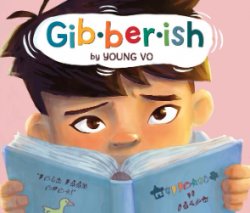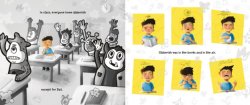Peter Shea, United States

Review of Gibberish, written and illustrated by Young Vo (Hoboken, NJ: Levine Querido, 2022). See Vo read and comment on the book (showing all pages) at http://www.youngvoart.com/about.html.
Sometimes, a children’s book describes a way that life doesn’t quite make sense, right away, and then leaves the reader to sort things out. Those were the books that Gareth Matthews liked best, for the Thinking in Stories column he created: simple books that could motivate long conversations. Arnold Lobel’s Frog and Toad stories provoke that kind of thinking.
But no one would suppose that investigating philosophical puzzles is all that parents and teachers can do with children around story time. Some books inform – supply facts. Conversation afterwards can probe what these facts add to our picture of the world. Others highlight an important human experience – and conversation, after reading the story, can bring up other examples, or name the feelings or connections the experience evokes. I think of books like Jane Yolen’s Owl Moon (1987), about a night walk into a forest to visit an owl. There are no questions there, exactly. It is just important that people do that, that this kind of adventure is a human option.
So, Thinking in Stories, as an ongoing column, selects just some of the valuable stories that adults and children might read together and suggests just some of the conversational roads they might travel afterward. It is sometimes hard to see, with a good book, what kind of good it is, and whether it fits within the limited scope of this collection.
Young Vo’s debut picture book Gibberish is about the experience of an outsider child named Dat, who does not know English, coming into an English-speaking school. Just from the jacket description, it isn’t clearly a thinking book at all; more an appreciation book or an empathy book. But Vo – as both author and illustrator – has done something special here: without leaving behind the experience of the new kid in the classroom, he has made that experience general, giving adults and children, native speakers and newcomers, something to talk about, and ask questions about, together.
Gibberish takes the point of view of the newcomer, the non-native speaker. “First Dat sailed on a boat, then flew on a plane, and today Dat will be on a school bus.” (1) At the beginning of the book, we are shown Dat’s new world: a mass of mysterious symbols and sound filling two full pages, and a herd of mis-shaped monsters grunting out noises. The two images are connected in our natural responses – at least in my natural responses: if some group is fluent in its own language, and I can’t break in, I have trouble liking the members of that group. It is a natural reflex to say: “they aren’t worth knowing” and “they’re probably dangerous.”

The progression of the book is beautifully and concisely constructed. As one classmate, Julie, takes an interest in the newcomer Dat, first finding things they can do together, then gradually developing a common language for common things, the world becomes less strange and – at the same time – the inhabitants of the world become less ugly, less demonic.
The authenticity of this narrative is due to the fact that Vo, now a Baltimore-based animator, author and illustrator, came to the United States as a young refugee from Vietnam. As a child, he learned how to draw before he learned how to write (which, he says, explains his affinity for picture books). To be a refugee is to be seen as strange – perhaps irredeemably – by the majority population; but Vo reminds us that from the perspective of the refugee, it is the majority who appear freakish.
And yet, what makes Gibberish a likely starting point for thinking and conversation is its universal subject. Everyone sometimes doesn’t understand what is going on, can’t find a way in, and everyone in that situation has impulses to retreat and to growl. (We all started off as babies.) It seems like a miracle to not retreat and not growl; maybe the first move is usually made by someone from the majority group. One of the virtues of this presentation is that many people will say: yes, that’s what it was like – when I started school; the first day of my new job; when I first opened the chemistry book; when I landed in Vienna; as the first person in my family to go to college; when I started playing violin. And that common topic invites philosophically interesting strategizing: how does one find one’s way into a bewildering situation? What does one do with the upwelling feeling of having fallen into a vat of monsters?
There are also great strategy questions from the other side: as a sympathetic insider, how does one diminish strangeness, find bravery to confront one’s discomfort, find common things, begin to put the common world in order? (Vo wrote this book as an appeal both to his younger self, the refugee child, and to friends (including a real Julie) who risked moving beyond their own comfort to connect with him.)
Whatever conversations arise, one effect of a book like Gibberish is to normalize this specific conceptual helplessness and the monster-perceptions that accompany it. This is what human beings go through, over and over, because they create languages and music and specialized skills – all these fenced areas – and then must find ways to jump the fences.
The places one can go with this book are limitless. When I started graduate school, the most popular book for my class was W.V.O. Quine’s Word and Object (1960), which begins with a story about two people who do not share a language. Quine asks how one could ever be sure that one understood what the other was saying, in that encounter. His book prompted a long and rich discussion in philosophy of language about meaning, understanding, and shared concepts.
With the help of his new friend, Dat, the outsider in Gibberish, will likely come to feel comfortable in his new classroom. The odd symbols and sounds that surround him will become familiar. (2) The monsters will start to look like children. It is one sort of inquiry to ask: how is it practically possible for this to happen? What is needed for this transition? It is another legitimate inquiry to ask about the basis and nature of those common and familiar worlds that people eventually establish with one another. What makes it possible for us to trust the words and symbols that we use? How can we trust the non-monsterhood of people from different worlds? To what extent is it possible and desirable to maintain fluency in both / multiple languages and cultural worlds? The book can take parents, teachers, and children as far into philosophy as they want to go. In this time when so many people are forced to move and start over, Gibberish is a welcome addition to the collection of stories to think with.
References
1. Quine, W.V.O. (1960) Word and Object. Cambridge, MA: MIT Press.
Lê, Minh (2022, March 8) P[olitics] & P[rose] Live! Young Vo | GIBBERISH with Minh Lê [Video, 52:42 min]. URL = http://www.youngvoart.com/about.html.
Yolen, Jane (1987) Owl Moon. New York: Philomel Books.
Footnotes
- Vo drew the school bus to resemble a giant caterpillar that devours the children who ride in it, because that is how he used to imagine it as a child (see Lê, 2022).
